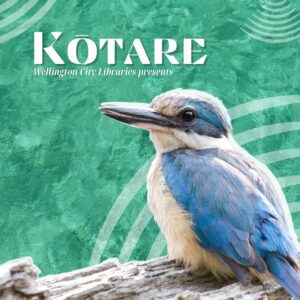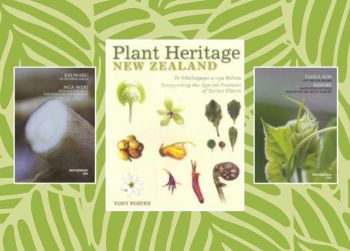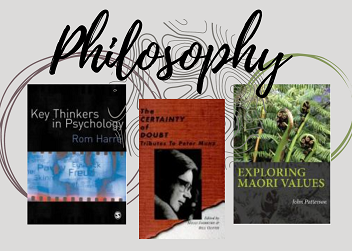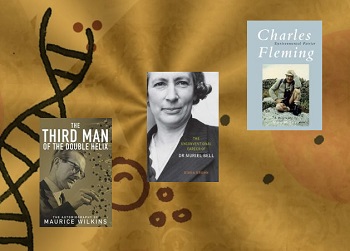Welcome to our latest exciting and scintillating episode of Books from the Vault, to be found on Wellington City Libraries’ very own podcast channel called Kōtare: Wellington City Libraries Presents. Books from the Vault is where three intrepid librarian explorers take an in-depth and fascinating look at some of the treasure trove of titles to be found in our stacks.
Tag: non-fiction
Native plants and their stories: Books from Te Pātaka
We’ve found some more hidden gems at Te Pātaka, this time about Aotearoa’s flora. Learn about vegetables that grow in our freshwater and coastal areas, waka carvers and farmers telling the story of the “mighty totara” tree, the iconic New Zealand pasture that was originally artificially created and learn about how seeds were precious during the colonial period. Read stories about how the landscape became what we see today.
Rauwaru, the proverbial garden : Ngā-weri, Māori root vegetables, their history and tips on their use / Roskruge, Nick
“The third booklet in a series aligned to Maori foods. 118 pages which introduce over 30 ngaweri or Maori green vegetables sourced from, the forest or bush, as weeds in cultivations, or as crops. Each ngaweri is introduced including whakapapa references, botanical status, utility and culinary use where possible. The book also includes recipes, a glossary of Maori terms and an example of the maramataka Maori.” (Adapted from the Catalogue)
Tōtara : a natural and cultural history / Simpson, Philip
“The ‘mighty totara’ is one of New Zealand’s most extraordinary, biggest and oldest trees. It’s the heart of Maori carving and culture, as fence posts on settler farms, clambered up in the Pureora protests of the 1980s: the story of New Zealand can be told through totara. In words and pictures, through inside waka and leaves, farmers and carvers, the author takes us deep the trees: their botany and evolution, their role in Maori life and lore, and their environmental and cultural significance.” (Adapted from Amazon.com)
The botanical adventures of Joseph Banks / Harrison, Christina
“Sir Joseph Banks was a true botanical adventurer and pioneer. Not only did he reveal the floral wonders of the South Seas, New Zealand and Australia to European eyes, but he set Kew Gardens on its path to becoming the world’s foremost botanic garden, bringing in a wealth of rare and useful plants, which had far-reaching impact. Banks was uniquely privileged and no-one before or since has had such influence in the sphere of botany.” (Adapted from the Catalogue)
Continue reading “Native plants and their stories: Books from Te Pātaka”
Books from Te Pātaka: Aviation stories of New Zealand
Read these fascinating stories of New Zealand’s legendary people in aviation. For example, a New Zealand pilot who searched the truth behind the MH370; the chief pilot of the former Air New Zealand who had a not so well-known world’s third fastest flying record; an aviation enthusiast who searched Devonport’s North Head for the world’s first two Boeing aircrafts; and the Westport’s pilot who founded the first commercial New Zealand airline. These true stories will let your imagination fly!
The truth behind the loss of Flight 370 / Wilson, Ewan
“New Zealand pilot Ewan Wilson and top journalist Geoff Taylor presents compelling evidence about MH370, some of it based on new interviews with family members of pilot Zaharie Ahmad Shah. This book takes us to Kuala Lumpur International Airport on March 8 and brings together the lives of passengers and crew who should’ve been a routine flight to Beijing on a well-respected airline operating a state-of-the-art airliner with a near faultless record.” (Adapted from the Catalogue)
Sundowner of the skies : the story of Oscar Garden the forgotten aviator / Garden, Mary
“On 16 October 1930, Oscar Garden taxied his tiny Gipsy Moth across London’s Croydon aerodrome and took off. His plan was to fly to Australia, which was sheer madness as he only had a mere 39 flying hours under his belt. He landed at Wyndham 18 days later. He was the third fastest after veteran aviators Bert Hinkler and Charles Kingsford. He then became the Chief Pilot of Tasman Empire Airways, former Air New Zealand.” (Adapted from the Catalogue)
Tunnel vision : unearthing the secrets of North Head / Butler, Martin
“On 12 October 1918, the New Zealand Flying School took possession of the first two Boeing aircraft ever made. Almost a century later aviation enthusiast Martin Butler search of any remnants of these famous planes. His journey takes him to North Head, Devonport’s famous military landmark, which has rumours about sealed-up tunnels. After twenty years of research and investigations, Butler uncovers a trail of deception and cover-ups as he attempts to unravel the mystery of what’s beneath North Head.” (Adapted from the Catalogue)
Continue reading “Books from Te Pātaka: Aviation stories of New Zealand”
Rare species of New Zealand: Books from Te Pātaka
If the discovery of an ancient New Zealand dolphin species intrigues you, you might be interested in reading books about the unique and wonderful species of Aotearoa. Read stories about the fairy tern, Māui dolphin, yellow-eyed penguin, kakī, greater short-tailed bat, and tāiko; some of which are New Zealand’s most endangered species. These books come with beautiful photos, interesting stories, and scientific discoveries to take you on a journey, exploring the unique creatures of the wilderness.
Rare wildlife of New Zealand / Ballance, Alison
“This book contains 100 New Zealand endangered species of all kinds: plants, birds, insects, fungi, mammals. Organised by habitat forests, gardens, islands, wetlands, high country, and sea and shore, it gives an important snapshot of the critical state of the wildlife in our country. Beautifully photographed with accessible and informative text. At the same time, it contains many surprises: among our most endangered species are kiwi, tuatara, flax, grasshoppers, hebes, crabs, and dolphins.” (Adapted from the Catalogue)
Whio : saving New Zealand’s blue duck / Young, David
“The blue duck, or whio, is one of New Zealand’s ancient treasures, a beautiful torrent duck that once lived on clear, fast-flowing rivers throughout most of the country. Sadly the blue duck now belongs to the ‘second tier’ of endangered species (including kaka, kea, parakeets and North Island brown kiwi) whose numbers have dropped alarmingly in the last 15 years. A dedicated group of scientists, field workers and volunteers have set about saving the blue duck.” (Adapted from the Catalogue)
The handbook of New Zealand mammals
“This is the only definitive reference on all the land-breeding mammals recorded in the New Zealand region (including the New Zealand sector of Antarctica). It lists 65 species, including native and exotic, wild and feral, living and extinct, residents, vagrants and failed introductions. It describes their history, biology and ecology, and brings together comprehensive and detailed information gathered from widely scattered or previously unpublished sources.” (Adapted from Amazon.com)
Continue reading “Rare species of New Zealand: Books from Te Pātaka”
World Philosophy Day 16 November
Celebrate World Philosophy Day with philosophy in New Zealand; from the famous argument of Sir Karl Popper to the traditions of Mātauranga Māori, plus some key thinkers such as Rom Harré and Peter Munze.
Beyond Wittgenstein’s poker : new light on Popper and Wittgenstein / Munz, Peter
“World renowned philosopher Sir Karl Popper worked in New Zealand in 1930-40s. In 1946, Ludwig Wittgenstein, the chair of Cambridge University Moral Science Club invited Popper to present a paper. The discussion turned into an argument, and Wittgenstein used a fireplace poker to emphasize his points. Then Popper replied that an example of a moral rule is `Not to threaten visiting lecturers with pokers′.” (Librarian’s review)
Key thinkers in psychology / Harré, Rom
“Book is written by New Zealand British philosopher Rom Harré. As recommended by The Psychologist `For anyone that has spent years rowing off into convoluted estuaries, and would like an entertaining and useful chart to remind them of River Psychology as a whole, I thoroughly recommend this book′ . This is a highly enjoyable, erudite and beautifully written manuscript. It conveys a rare depth of understanding and ability to strike at the core debates. ‘ – Dr Steve Brown, Loughborough University” (Adapted from Amazon.com)
Exploring Māori values / Patterson, John
“This book, first published in 1992, offers Pakeha New Zealanders an insight into Maori thought and values and the basis for the sort of understanding and partnership that should exist between Pakeha and Maori. It also presents a new perspective from which long-held Pakeha values can be reassessed. He demonstrates a high degree of empathy with and respect for Maori and the book offers a practical model for engagement with this culture and for greater mutual understanding. “(Adapted from the Catalogue)
The certainty of doubt : tributes to Peter Munz
“These essays are written by Peter Munz’s friends and colleagues to celebrate his 75th birthday. They write on broad themes, the philosophy of history and science and the problems of knowledge and in doing so they reflect the growth and breadth of Munz’s intellectual interests and achievements. These essays are major contributions to their fields, which range from 5th century monastic life to claims before the Waitangi Tribunal to the importance of evolutionary theory for history and philosophy.” (Adapted from the Catalogue)
The life of New Zealand’s extraordinary scientists
Read stories of New Zealand’s own prominent scientists who changed our lives, from diet to DNA, and from environment patriot to expert witness. Some of their contributions we have taken for granted today, but were revolutionary at the time.
The unconventional career of Dr Muriel Bell / Brown, Diana
“Appointed New Zealand’s first state nutritionist in 1940, Muriel Bell was behind ground-breaking public health schemes such as milk in schools, iodised salt, and water fluoridation. The first woman in New Zealand to be awarded the research degree of Doctor of Medicine, in 1926, her pioneer research on vitamins and minerals helped to prevent deficiency diseases. Her early research into fats and cholesterol tackled the complexity of nutrition-related aspects of coronary heart disease. (Adapted from the Catalogue)
Peter Snell : from Olympian to scientist / Snell, Peter
“Peter Snell has won three gold medals and was named New Zealand Sportsman of the year in 1960 and 1964, and New Zealand Order of Merit in 2002, and became Sir Peter Snell in 2009. He then moved to US and pursued a successful career in exercise physiology. This biography is the full account of Peter Snell’s life as sensational athlete and respected scientist and academic. It picks up the story from Peter’s first biography No Bugles, No Drums, which was published in 1965.” (Adapted from the Catalogue)
Continue reading “The life of New Zealand’s extraordinary scientists”








